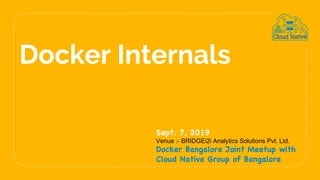September 7, 2019 Cloud Native and Containerisation (Joint Meetup with Docker Bangalore) - Docker Internal - Sangam Biradar
- 1. Docker Internals Sept. 7, 2019 Venue :- BRIDGEi2i Analytics Solutions Pvt. Ltd. Docker Bangalore Joint Meetup with Cloud Native Group of Bangalore
- 2. 2 $Whoami Sangam Biradar Github-sangam14 Twitter-@BiradarSangam $curl engineitops.com engineitops.icu - My Personal Blog Website - Over 100+ blog post on docker | Golang and kubernetes and cloud - Unique 50000+ hits | Dockerlabs Active Contributor - Educated around 1000+ student - Research Papers Presented/Published in the Conference Proceedings(IEEE) 1.“Build Minimal Docker Container Using Golang’’- presented and published in the proceedings of the International Conference ICICCS2018 at Vaigai College Of Engineering, Madurai 14 June 18 - 2."Algo_Seer: System for Extracting and Searching Algorithms in Scholarly Big Data"- presented and published in the proceedings of the International Conference ICICV 2019 Springer Lecture Notes on Data Engineering and Communications Technologies. Francis Xavier Engineering College,Tirunelveli.14 feb 19 Series Editor: Xhafa, Fatos ISSN: 2367-4512
- 3. Outline 3 ● What is container – overview ● The building Blocks [ namespaces , Control groups , copy-on-write storage , union filesystem ] ● Container Runtime ● Demo
- 5. Container ● A definition says “Containers are an abstraction at the app layer that packages code and dependencies together”. It practically means just the Application and its dependent binaries and libraries are packaged into a container with no extra baggage of an operating system. 5
- 6. “ How its work then? 6
- 7. 7 Pre –virtualization - To hypervisor base virtualization world To container base virtualization world
- 8. 8 Daemon running on the host OS
- 9. The building Blocks [ namespaces , Control groups , copy-on-write storage , union filesystem ] 9
- 10. Cgroups (control Group) ● first idea that should come to mind is of resource management ● Resource metering and limiting memory CPU block I/O ● network* Device node (/dev/*) access control Crowd control 10
- 11. ● Each subsystem has a hierarchy (tree) separate hierarchies for CPU, memory, block I/O... ● Hierarchies are independent the trees for e.g. memory and CPU can be different ● Each process is in a node in each hierarchy think of each hierarchy as a different dimension or axis ● Each hierarchy starts with 1 node (the root) Initially, all processes start at the root node* ● Each node = group of processes sharing the same resources 11
- 12. ● Keeps track of pages used by each group: file (read/write/mmap from block devices) anonymous (stack, heap, anonymous mmap) active (recently accessed) inactive (candidate for eviction) ● Each page is “charged” to a group ● Pages can be shared across multiple groups ● e.g. multiple processes reading from the same files when pages are shared, only one group “pays” for a page 12 Memory Cgroups
- 13. Memory limits ● Each group can have its own limits ● limits are optional two kinds of limits: soft and hard limits ● Soft limits are not enforced ● they influence reclaim under memory pressure ● Hard limits will trigger a per-group OOM killer ● Limits can be set for different kinds of memory ● physical memory ● kernel memory ● total memory 13
- 14. BlKIO Cgroup ● Keeps track of I/Os for each group per block device read vs write sync vs async ● Set (limits) for each group per block device , read vs write , ops vs bytes ● Set relative weights for each group ● Note: most writes go through the page cache ● so classic writes will appear to be unthrottled at first 14
- 15. ● Automatically set traffic class or priority, for traffic generated by processes in the group ● Only works for egress traffic ● Net_cls will assign traffic to a class ● class then has to be matched with tc/iptables, otherwise traffic just flows normally ● Net_prio will assign traffic to a priority ● priorities are used by queuing disciplines 15 Net_cls Net_prio Cgroup
- 16. ● Pid – (Process isolation) ● Net – (Network isolation) ● mnt – ( Filesystem mount points isolation) ● UTS – (Nodename and Domainname isolation) ● IPC – (Inter Process Communication resource isolation) ● User - User name space Namespaces 16
- 19. Create own container using golang 19 IEEE PAPER : https://ieeexplore.ieee.org/author/37086701647
- 20. 20 https://www.technoarete.org/common_abstract/pdf/IJER CSE/v5/i3/Ext_97135.pdf International Journal of Engineering Research in Computer Science and Engineering (IJERCSE) Vol 5, Issue 3, March 2018 Build Minimal Docker Container Using Golang [1] Biradar Sangam.M
- 21. 21
- 23. 23 Thanks! Any questions? You can find me at twitter @BiradarSangam or visit engineItops.com

